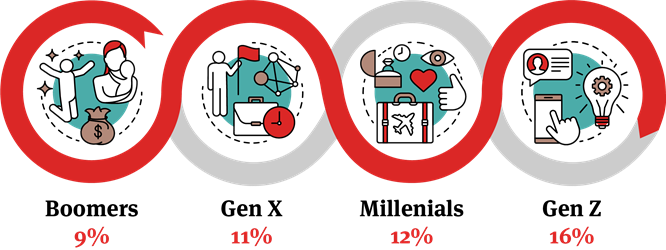We considered the growth in the number of employees ‘working from anywhere’ in our previous articles.
We will now focus on suitability - does ‘work from anywhere’ suit all jobs, all countries, and all employees?
In relation to job suitability, the answer is clear. “More than half the workforce…has little or no opportunity for remote work.”1

Many employees work in jobs that “require them to turn up, not just log in”2 and despite the growth in ‘work from anywhere’, the life of these frontline workers “isn’t going to change much.”2
‘Work from anywhere’ primarily benefits white-collar knowledge workers, for whom “the pandemic has afforded many new perks that were practically unheard of pre-pandemic (including) the ability to work from home or remotely long-term.”3
Prior to “2020 a movement was brewing within knowledge-work organizations. Personal technology and digital connectivity had advanced so far and so fast”5 that during the pandemic lockdowns, many knowledge workers discovered they “don’t in fact need to be co-located with colleagues on-site.”4
After examining industry sector suitability, McKinsey concluded that remote work potential in the United States is concentrated in “the finance, management, professional services, and information sectors.”1
Each country also has a different level of potential for remote work, “a reflection of their sector, occupation, and activity mix.”1 The theoretical maximum share of time working remotely (with some level of diminished productivity) by country is estimated to be:1
So if ‘work from anywhere’ doesn’t suit all jobs and all countries, does it suit all types of employees?
Analysis of LinkedIn data covering millions of members found that “women, Gen Z and those without a graduate degree” are “more likely to apply for remote versus on-site positions.”5
Although Gen Z employees aspire to ‘work from anywhere’, they are also “more likely to be single and early in their careers, making them more likely to feel the impacts of isolation, struggle with motivation at work, or lack the financial means to create proper workplaces at home.”5
As early-career employees who have had less opportunity to build meaningful connections within their team and organisation, it is worth noting that Gen Z may also lack the confidence to contribute in certain situations.
One example is that “Gen Z is struggling more than other generations” to get “a word in during conference calls and meetings” as follows:5

In contrast, Millennials show a liking for ‘work from anywhere’, and they “are abandoning the big cities to search for greener pastures, leaving the office and the daily commute behind to raise their families in the regions.”6
Microsoft also found “that Black and U.S. Latino workers are more likely than white workers and men to say they prefer remote work.”5
Finally, in a recent survey of remote workers in five countries, “roughly half of the parents and caregivers surveyed pursued remote work because of their status as parents/caregivers.”7

| |
Yes |
No |
| Are You a Parent or Caregiver? |
35% |
65% |
|
Is Being a Parent or Caregiver one
of the Reasons you Pursued Remote Work? |
48% |
52% |
In summary, suitability to ‘work from anywhere’ clearly differs by job, industry sector, country, and employee type.
Our next article will discuss the growing popularity of the hybrid model, where employees working from anywhere spend part of their work time rotating “in and out of offices configured for shared spaces.”8
Norton Rose Fulbright assists organisations to efficiently and effectively address the legal aspects of the new global work environment, including work from anywhere. Please reach out if we can assist your organisation in this respect.













